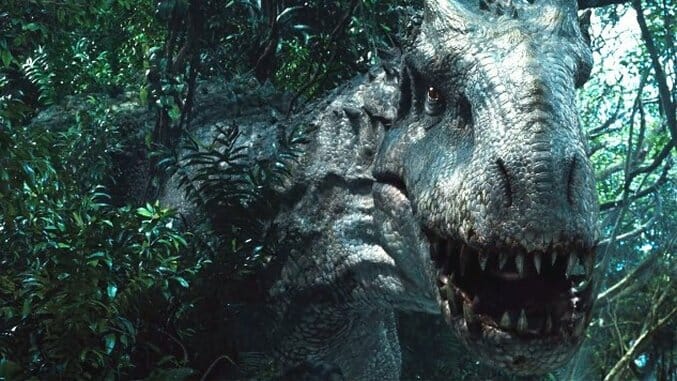Jurassic World’s Antagonist Problem: Can Dinosaurs Be “Villains”?

It’s been 13 years since the last time audiences set foot within the dream space of the Jurassic world, and in that time, much has changed. CGI and 3D effects ascended to a new level via Avatar. The world forgot most of the franchise-deflating disappointments of Jurassic Park III. The fictional John Hammond passed away alongside the actor who brought him to life, Richard Attenborough. And along the way, Hollywood apparently forgot what the first film was all about—but are you really surprised?
The original Jurassic Park, in no uncertain terms, was one of the formative films of my youth. I was seven when it came out in 1993, too young perhaps to go see the film in theaters, but I soon saw it elsewhere. And then saw it again, and again. I’d already gone through the dinosaur phase that so many young boys find themselves engrossed in, but it probably hit me a bit harder than most. There are photos of me in a third-grade classroom wearing a floppy fedora and blue shirt like Dr. Alan Grant from that first film. Other kids can be seen in the background wearing lab coats or chefs hats. It was some variant on “what do you want to be when you grow up?” day. And I was there to represent the rootin’, tootin’ Action Paleontologists of Jurassic Park.
And so, please realize it comes from a place of love when I say that Jurassic World has me worried. Not about things so paltry as the CGI, which whipped up a big fanboy conversation when the first trailer was released last year, but about things I believe are much more integral to its success. In chief, I’m concerned about the issue of antagonists. Because to have an “evil” dinosaur as a villain is a radical departure from the spirit of the original, and I’ll do my best in this space to explain why.
First, let’s agree upon one thing: The dinosaurs of Jurassic Park are neither good nor evil, because they’re animals. An animal cannot truly be evil, because to do so requires knowledge of good and at least the suggestion of sentience. Even the raptors of the original film, so often lauded for their intelligence, don’t engineer their own escape and aren’t truly “evil.” They may be more capable, but they’re still just animals, doing what comes naturally to them. In that way, they’re essentially outside of blame for their actions—it’s always the fault of man when he comes into contact with them. Don’t want to get eaten by raptors? Then don’t create raptors and free them from their paddocks to run amok—that’s just asking for devouring via raptor.
This is a single instance of Jurassic Park’s greatest recurring theme, as it’s casually laid out by Jeff Goldbum’s Ian Malcom during the guided tour of the island: chaos theory. The concepts of chaos theory crop up constantly throughout the film as we’re reminded over and over again that man, as a species, thinks he has a great degree more control over his surroundings than he really does. In reality, the complex systems of fate, chance and unknowable variables all operate on levels completely beyond our understanding, and any attempt to control them is hopeless. It’s not just about the dinosaurs figuring out how to breed—it’s everywhere. Hammond’s choice to employ Wayne Knight’s Dennis Nedry is a prime example: Hammond believes he can control all of the interconnected systems at his fingers, including the people, but there’s always a spanner in the works. One failure in that system—whether it’s the greed of a Dennis Nedry or the shut-down of an electric fence—and you’ve got an unbalanced equation spinning toward a deadly conclusion.
The point is, in Jurassic Park, it’s always man and his hubris that is the villain. It’s something the second film, The Lost World also understood for the most part, but was lost by the time Jurassic Park III came out, to the series’ detriment. And in Jurassic World, it’s the new ” Indominus Rex ” that raises similar concerns.
-

-

-

-

-

-

-

-

-

-

-

-

-

-

-

-

-

-

-

-

-

-

-

-

-

-

-

-

-

-

-

-

-

-

-

-

-

-

-

-








































